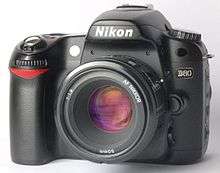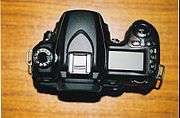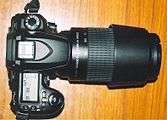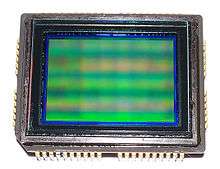Nikon D80
 | |
| Overview | |
|---|---|
| Type | Digital single-lens reflex |
| Lens | |
| Lens | Interchangeable, Nikon F-mount |
| Sensor/Medium | |
| Sensor |
23.6 mm × 15.8 mm Nikon DX format RGB CCD sensor, 1.5 × FOV crop |
| Maximum resolution | 3,872 × 2,592 (10.2 effective megapixels) |
| ASA/ISO range | 100–1600 in 1/2 or 1/3 EV steps, up to 3200 as boost |
| Recording medium | Secure Digital, SDHC compatible |
| Focusing | |
| Focus modes | Instant single-servo (AF-S); continuous-servo (AF-C); auto AF-S/AF-C selection (AF-A); manual (M) |
| Focus areas | 11-area AF system, Multi-CAM 1000 AF Sensor Module |
| Exposure/Metering | |
| Exposure modes | Programmed Auto [P] with flexible program; Shutter-Priority Auto [S]; Aperture Priority Auto [A]; Manual [M] |
| Exposure metering | TTL 3D Color Matrix Metering II metering with a 420 pixel RGB sensor |
| Metering modes | 3D Color Matrix Metering II, Center-weighted and Spot |
| Flash | |
| Flash | Built in Pop-up, Guide number 13m at ISO 100, Standard ISO hotshoe, Compatible with the Nikon Creative Lighting System |
| Shutter | |
| Shutter | Electronically controlled vertical-travel focal-plane shutter |
| Shutter speed range | 30 s to 1/4000 s and Bulb, 1/200 s X-sync |
| Continuous shooting | 3 frame/s up to 100 JPEG or 6 RAW images |
| Viewfinder | |
| Viewfinder | Optical 0.94× Pentaprism |
| Image Processing | |
| Custom WB | Auto, Incandescent, Fluorescent, Sunlight, Flash, Cloudy, Shade, Kelvin temperature, Preset |
| General | |
| Rear LCD monitor | 2.5-inch (64 mm) TFT LCD, 230,000 pixels |
| Battery | Nikon EN-EL3e Lithium-Ion battery |
| Optional battery packs | MB-D80 battery pack (with vertical shutter release) with one or two Nikon EN-EL3e or six AA batteries |
| Weight | Approx. 585 g (1.290 lb) without battery, memory card, body cap, or monitor cover |
| Made in | Thailand |
The Nikon D80 is a digital single-lens reflex camera model announced by Nikon on August 9, 2006.[2] The camera shipped the first week of September to US retailers. Considered by many to be a hybrid of design elements of the entry-level D50 and high-end D200 cameras, it occupied the same price bracket the Nikon D70 did at the time of its release. It was replaced by the Nikon D90 in August 2008.
Features
- 10.2 Megapixel CCD sensor
- Seven preset scene modes (Auto, Portrait, Landscape, Macro, Sports, Night Landscape and Night Portrait) selectable using a top-mounted dial
- User-selectable image optimization options (Normal, Softer, Vivid, More vivid, Portrait, Custom and Black-and-white)
- In-camera Retouch feature with D-Lighting, Red-eye correction, Trim, Image overlay, Monochrome and Filter effects
- In-camera Multiple exposure feature (merges up to three consecutive images)
- USB 2.0 Hi-speed interface
- Pentaprism viewfinder, rather than the more compact penta-mirror set up (0.94× magnification vs. 0.8× for the D40x). Same one on D200.
- 2.5 inch, 230,000 pixel LCD monitor (same as in D40, D40x and D200).
The Nikon D80 also inherits some of the D200's features such as the 10.2 MP image sensor, albeit with slower data throughput than the D200. The D80 is the second Nikon DSLR to use the SD card (the D50 being the first), rather than the CF card storage used in the D70, D70s and D200 and higher-end models. The higher storage capacity SDHC standard is also supported.
Optional accessories
- Wireless ML-L3 (IR) remote control and MC-DC1 remote cord
- Battery MB-D80 battery grip. Cheaper after-market clones exist.
Firmware
The last firmware set was released September 24 2008. v1.11 is the last version number for the A and B firmware. As of August 2018, it is available on the Nikon support site. The last firmware release coincides with the release of the D90, the replacement of the D80.
Images
 D80 body
D80 body D80 body top view
D80 body top view D80 with 70-300mm lens
D80 with 70-300mm lens D80 with 70-300mm lens top view
D80 with 70-300mm lens top view
See also
References
- ↑ "Nikon D80". Digital SLR Cameras products line-up. Nikon Corporation.
- ↑ "Outstanding performance, ease of operation, versatile personal control and exciting in-camera effects make digital SLR photography more rewarding for all" (Press release). Nikon Corporation. 2006-08-09. Archived from the original on 2006-08-14.
External links
| Wikimedia Commons has media related to |
- Nikon D80 – Nikon global website
- Nikon D80 – Nikon USA website
- Digital Photography Review of the D80
- Outdoor Photographer Nikon D80 Review
- Reviews Index for Nikon D80
See also: Nikon 1 / F-mount – Teleconverter – CX / DX format – Speedlight – Expeed | |||||||||||||||||||||||||||||||||||||||||||||||||||||||||||||||||||||||||||||||||||||||||||||||||||||||||||||||||||||||||||||||||||||||||||||||||||||||||||||||||||||||||||||||||||||||||||||||||||||||||||||||||||||||||||||||||||||||||||||||||||||||||||||||||||||||||||||||||||||||||||||||||||||||||||||||||||||||||||||||||||||||||||||||||||||||||||||||||||||||||||||||||||||||||||||||||||||||||||||||||||||||||||||||||||||||||||||||||||||||||||||||||||||||||||||||||||||||||||||||||||||||||||||||||||||||||||||||||||||||||||||||||||||||||||||||||||||||||||||||||||||||||||||||||||||||||||||||||||||||||||||||||||||||||||||||||||||||||||||||||||||||||||||||||||||||||||||||||||||||||||||||||||||||||||||||||||||||||||||||||||||||||||||||||||||||||||||||||||||||||||||||||||||||||||||||||||||||||||||||||||||||||||||||||||||||||||||||||||||||||||||||||||||||||||||||||||||||||||||||||||||||||||||||||||||||||||||||||||||||||||||||||||||||||||||||||||||||||||||||||||||||||||||||||||||||||||||||||||||||
